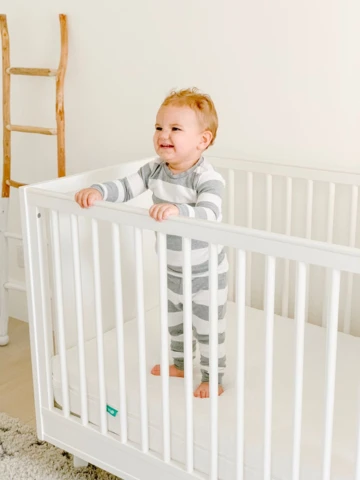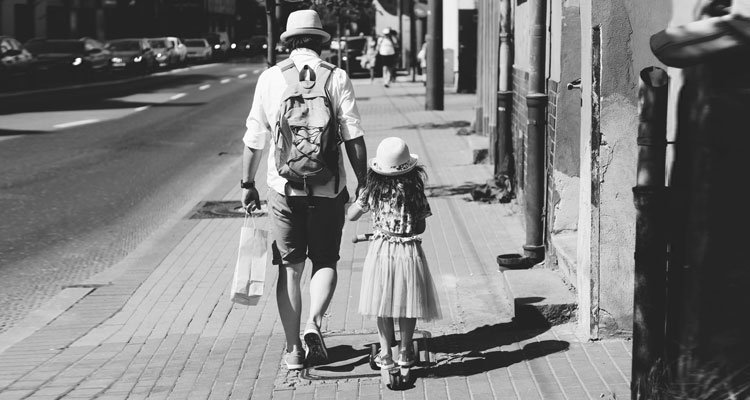Lower the crib when your baby starts sitting up. This usually happens between 5 to 8 months.
Adjusting the crib height ensures your baby’s safety as they grow and explore. Becoming a parent involves many decisions. One crucial choice is knowing when to lower the crib. As babies grow, they become more mobile and curious. They start sitting up, pulling themselves up, and even trying to climb.
These milestones can lead to potential risks if the crib height is not adjusted. Understanding the right time to lower the crib can prevent falls and ensure your child’s safety. It’s essential to be proactive and monitor your baby’s development. Safety is a top priority, and knowing when to lower the crib is a key part of that. This decision helps create a secure environment for your little one to sleep and play.
Importance Of Crib Safety
Lowering the crib mattress is crucial as your baby grows and starts sitting or pulling up. It prevents falls and ensures your baby’s safety. Adjust the crib height timely to match your child’s development stages.
Crib safety is crucial for every parent. Ensuring your baby’s crib is safe means you’re providing them with a secure environment to grow and sleep. As your baby begins to grow, knowing when to lower the crib becomes vital. It’s not just about adjusting the height; it’s about safeguarding your little one’s well-being.###Protecting Your Baby
Your baby is curious, and as they grow, their ability to move and explore increases. Lowering the crib at the right time can prevent them from climbing over the rails. A friend once told me about how her little one attempted to climb out of the crib. Luckily, she had lowered it just in time.The crib’s height should match your baby’s development stage. When they start pulling themselves up or sitting, it’s time to think about lowering the crib. This adjustment protects your baby from potential falls and injuries.###Avoiding Accidents
Accidents can happen in a blink. With a lowered crib, you reduce the risk of your baby falling out. Imagine your baby excitedly bouncing in their crib; if it’s too high, they could topple over.By lowering the crib, you’re taking a proactive step in accident prevention. It’s about being prepared and staying a step ahead. Have you adjusted the crib recently? Checking regularly ensures your baby’s safety as they grow.Crib safety is not just about following guidelines; it’s about understanding your baby’s needs and making timely changes. Engage with your baby’s growth, and you’ll find the right time to lower the crib.
Credit: www.newtonbaby.com
Signs It’s Time To Lower The Crib
Parents often wonder when to adjust their baby’s crib height. Safety is a top priority. Knowing when to lower the crib keeps your baby safe as they grow. Recognizing key signs helps make this decision easier. Let’s explore these signs.
Baby’s Growth Milestones
Babies grow quickly in their first year. As they reach new milestones, their cribs need adjustments. When your baby begins to sit up, it’s a sign. They have the strength to move around more.
Another milestone is pulling up to stand. This shows increased curiosity. They might try to explore their surroundings. Lowering the crib ensures they can’t climb out and fall.
Increased Mobility
As babies grow, their mobility increases. Rolling over is an early sign. This indicates they can move more freely. A mobile baby could accidentally topple out if the crib is too high.
Once they crawl, their reach extends. They can grasp crib edges. Climbing becomes a possibility. A lowered crib prevents accidents during these active phases.
Recognizing these signs helps keep your little one safe. Adjust the crib as they grow and explore. Safety and comfort go hand in hand during this exciting time.
Risks Of Not Lowering The Crib
Lowering the crib at the right time is crucial for safety. Many parents may not realize the risks involved in delaying this important adjustment. Not lowering the crib can lead to dangerous situations. Understanding these risks helps keep your baby safe and secure.
Potential Falls
Babies grow and learn to stand quickly. As they pull up, the crib’s height becomes a risk. A high crib increases the chance of falls. Babies are curious and may try to climb out. A fall from a crib can cause serious injuries. Lowering the crib reduces this risk significantly.
Injury Prevention
Preventing injuries is a top priority for parents. An elevated crib can lead to bumps and bruises. Babies can hit their heads if the crib is too high. Adjusting the crib height helps avoid these injuries. A safer crib environment supports your baby’s well-being.
How To Lower The Crib Safely
Lowering the crib becomes necessary as your baby grows and starts pulling up or standing. Ensure the mattress is at the right level to prevent climbing out. Adjust the crib height when your child reaches milestones like sitting, pulling up, or standing independently.
Safety is key during this transition.
Lowering a crib might seem like a simple task, but it’s crucial for your baby’s safety. As your little one grows, especially when they start pulling themselves up, adjusting the crib height can prevent accidents. But how do you ensure you’re doing it right? Let’s dive into how to lower the crib safely, ensuring a secure environment for your baby without the stress.Tools Needed
Before you start, gather everything you need to make the process smooth. A screwdriver is often essential, as most cribs are assembled with screws. Check your crib manual for any specific tools required. Having the manual handy can save time and confusion.Step-by-step Process
Start by removing the mattress from the crib. This gives you a clear view of the crib’s hardware.Next, locate the bolts or screws that secure the crib mattress support. Usually, these are found at each corner of the crib. Use your screwdriver to loosen them. Don’t remove them entirely, just enough to adjust the height.Lower the mattress support to the desired level. Make sure it clicks or secures into the new position. This is usually the lowest setting for older babies who are starting to stand.Tighten the screws securely. This ensures that the mattress support is stable and won’t move when your baby shifts around.Finally, replace the mattress and test the crib’s stability. Give it a gentle shake to make sure everything is solid.Have you ever thought about why it’s crucial to lower the crib at the right time? It’s not just about following guidelines; it’s about anticipating your baby’s next milestone.By lowering the crib safely, you’re not only protecting your baby but also giving yourself peace of mind. Remember, it’s the small adjustments that make a big difference in your baby’s safety.Common Mistakes To Avoid
Lowering a crib too soon can lead to safety risks. Ensure your child can sit up or pull themselves up before adjusting the crib height. Avoid waiting too long, as active toddlers might climb out, increasing fall hazards. Always prioritize your child’s safety when deciding on crib adjustments.
When adjusting your baby’s crib, several common mistakes can occur. These errors might seem minor. But they can affect your baby’s safety. Recognizing and avoiding these mistakes ensures a safer sleep environment.Incorrect Height
Setting the crib at the wrong height is a frequent mistake. Parents often leave the crib too high. This is risky once the baby starts moving. Babies quickly learn to pull themselves up. A high crib increases the risk of falls. Always adjust the crib as your baby grows. Check your crib’s manual for height recommendations. Follow these guidelines to keep your baby safe.Ignoring Signs
Parents sometimes miss important signs that indicate a crib adjustment. Babies give cues when ready for a lower crib. Look for signs like pulling up or standing. Ignoring these can lead to accidents. Regularly observe your baby’s development stages. Make timely adjustments to the crib height. This vigilance helps prevent potential hazards.
Credit: www.tiktok.com
Adjusting The Crib For Different Ages
Crib safety is essential for a baby’s growth. Adjusting the crib height ensures comfort and safety. Parents must know how to set the crib for different ages. This helps prevent falls and supports development. Let’s explore how to customize crib settings for infants and toddlers.
Infants Vs Toddlers
Infants need a higher crib setting. This makes it easier to lift and lay them down. With newborns, the crib mattress should be at the top level. This helps parents reach the baby without bending too much. When babies start rolling, lower the mattress. This prevents them from climbing out.
Toddlers are more active. Their curious nature can lead to climbing attempts. Lower the crib mattress for them. This setting ensures they can’t climb over the crib rails. As they grow taller, keep adjusting the crib height. Always check if your toddler can stand and reach the top.
Customizing Settings
Every child grows differently. Regularly check the crib height. Adjust it based on your child’s development. Watch for signs of rolling or standing. These are cues to lower the crib. Use the crib’s manual for guidance on height settings. Most cribs offer multiple levels for adjustment.
Safety is a priority. Ensure the crib rails are high enough. Measure the distance between the mattress and the top rail. Keep toys and blankets out of reach. This prevents any climbing accidents. Adjusting the crib is part of creating a safe sleep environment.
Monitoring Your Baby’s Sleep Environment
Monitoring your baby’s sleep environment is crucial for their safety. Parents often worry about the right time to adjust the crib height. Knowing when to lower the crib ensures your baby sleeps securely. Regularly checking your baby’s sleep space can prevent accidents.
Regular Safety Checks
Conduct regular safety checks to maintain a safe sleep environment. Inspect the crib for loose screws or broken parts. Ensure the mattress is firm and fits snugly. Check for gaps between the mattress and crib sides. These gaps could pose a risk to your baby. Adjust the crib mattress height as your baby grows. A lower mattress prevents climbing accidents when your baby starts standing.
Crib Accessories
Choose crib accessories wisely to ensure safety. Use fitted sheets that stay in place on the mattress. Avoid pillows, blankets, and stuffed toys inside the crib. These items increase the risk of suffocation. Consider a sleep sack for warmth instead of loose blankets. Remove any hanging toys or mobiles as your baby grows. These can become hazards as your baby becomes more active. Regularly assess crib accessories to keep them safe for your baby.

Credit: www.prwe.com
Expert Advice On Crib Safety
Ensuring your baby’s crib is safe is crucial for their well-being. Experts agree that understanding when to lower the crib is key. This decision affects your baby’s safety and development. Learn from pediatricians and safety standards to make informed choices.
Pediatrician Recommendations
Pediatricians recommend lowering the crib when your baby starts sitting. This usually happens around 5 to 6 months. Babies grow quickly, and their abilities change rapidly. Once they can pull up, the crib should be at its lowest setting. This prevents falls as they become more mobile. Always consult your pediatrician for personalized advice.
Safety Standards
Crib safety standards ensure your baby’s sleep environment is secure. The Consumer Product Safety Commission (CPSC) sets strict guidelines. Crib slats should be no more than 2 3/8 inches apart. This prevents your baby’s head from getting stuck. The mattress should fit snugly with no gaps. Regularly check for recalls on cribs and accessories. Follow assembly instructions carefully to avoid hazards.
Frequently Asked Questions
When Should I Lower The Crib Level?
Lower the crib when your baby starts sitting up or pulling to a standing position. Ensure safety by adjusting the crib height promptly. Regularly check the crib level as your baby grows. Always prioritize your child’s safety and comfort in their sleeping environment.
At What Height Should A Baby Be Out Of The Crib?
Move a baby out of the crib when they reach 35 inches in height. Ensure safety by transitioning to a toddler bed. Monitor their ability to climb out, as this can also indicate the need for a change. Prioritize your child’s safety during sleep.
When Can I Put My Baby Down In His Crib?
Place your baby in the crib when they are sleepy but still awake. Ensure the crib is safe and comfortable. Follow sleep guidelines for newborns and infants. Establishing a bedtime routine helps signal sleep time. Consult your pediatrician for personalized advice based on your baby’s developmental stage.
How To Know If A Crib Is Too Small?
Ensure the crib allows your baby to stretch out comfortably. Check for at least 2 inches of space above their head. Verify their ability to move freely without touching the sides. Ensure the crib meets safety standards for size. Regularly assess growth to determine if a larger crib is needed.
When Should I Lower The Crib Mattress?
Lower the crib mattress when your baby can sit up. This ensures safety.
Conclusion
Lowering the crib ensures your baby sleeps safely. Always watch for signs. Is your baby starting to sit or pull up? Time to lower the crib. Safety first! Adjust the crib as your child grows. Keep the mattress firm and secure.
Check crib slats for safety. Regularly inspect the crib structure. A safe sleep space is crucial. Follow guidelines for peace of mind. Your baby’s safety depends on your vigilance. Keep your baby’s sleep environment safe and comfortable. Making timely adjustments is key.
Always prioritize your child’s well-being. Stay informed and proactive about crib safety.





